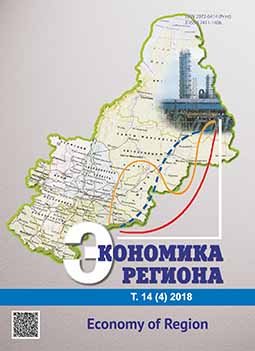Взаимовлияние производственной специализации региона и внутрирегиональных кластеров
Influence of Regional Industrial Specialty to the Emergence of Intraregional Clusters
Author(s): Olga Petrovna IvanovaSubject(s): Economy
Published by: Институт экономики Уральского отделения Российской академии наук
Keywords: ;industrial specialization;region;localization;concentration;cluster;Kemerovo region;development;mutual influence;evaluation;diversification;
Summary/Abstract: In the conditions of developing cluster policy and the application of cluster approach by regions, the issues of interference assessment of clusters and regional economics become essential. The purpose of the paper is to determine if created clusters allow to develop and, in particular, diversify the economy of a region, as well as to identify whether the industrial specialization of a region influences the specialization and success rate of clusters under formation. The method includes two parts. First of all, it is the assessment of the cluster development level and the identification of the influence of regional specialization on cluster development. The second part is the assessment of regional industrial specialization within the period of cluster functioning. I have distinguished factors conditioned by regional industrial specialization, which are important for cluster formation. The extractive specialization of Kemerovo region (the contribution of mining operations to the gross value added of the region was more than 25 % in 2015) defined the specialization of only one cluster connected with coal and conversion. The analysis of biomedical, tourist-recreational, agro-industrial clusters, created in the region within the period 2011–2016, showed that prerequisites for cluster formation were the concentration of participants, their territorial proximity, share of small and mediumsized enterprises in a cluster, scientific, technological and educational potential of the territory, tendency to structural changes and natural potential, cooperation in the industry and science, and last, the strategy of development of a cluster. Cluster forms in those types of economic activity, which are less provided with investment but require the incorporation of resources for development, including through the mechanisms of governmental support. The level of development of created clusters has not influenced any changes in the region specialization. For the period of clusters existence, there has been the increase of the index of production per capita in the trade group “coal” (from 29.68 in 2011 to 31.72 in 2016), Herfindahl-Hirschman index in 2012 was 1366.89, in 2015 it was 1327.65; the regional marketability index for coal over a period of 2014–2016 changed from 0.98 to 0.93. This result might be applied to actualize the strategy for regional development as well as for the implementation of measures for cluster support.
Journal: Экономика региона
- Issue Year: 14/2018
- Issue No: 4
- Page Range: 1207-1220
- Page Count: 14
- Language: Russian

